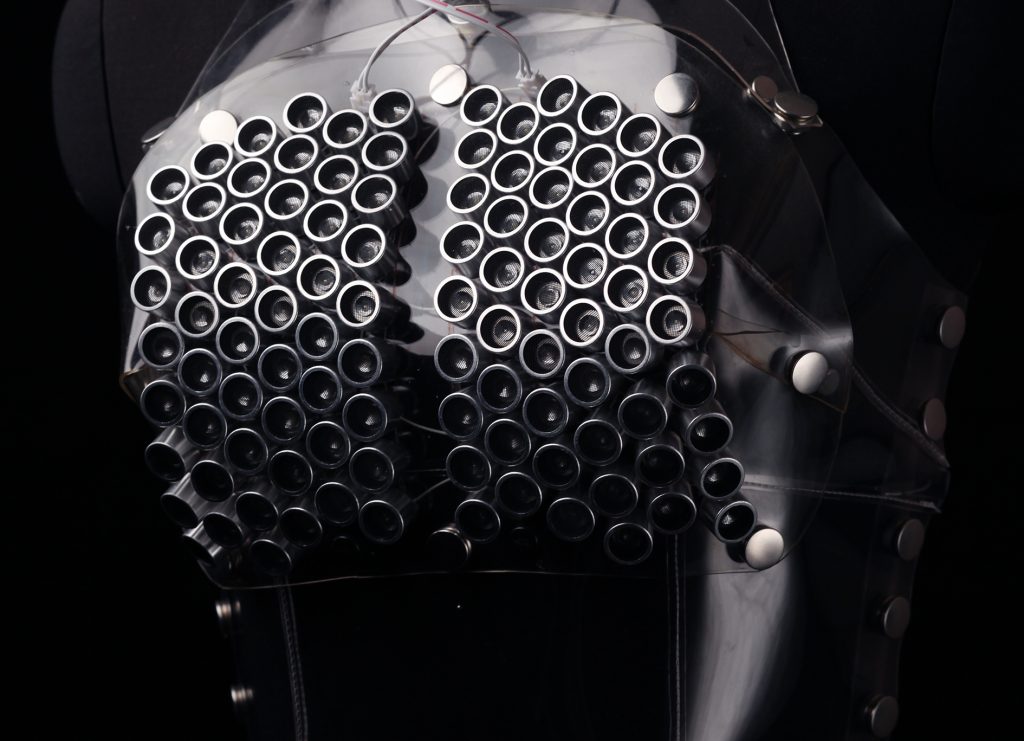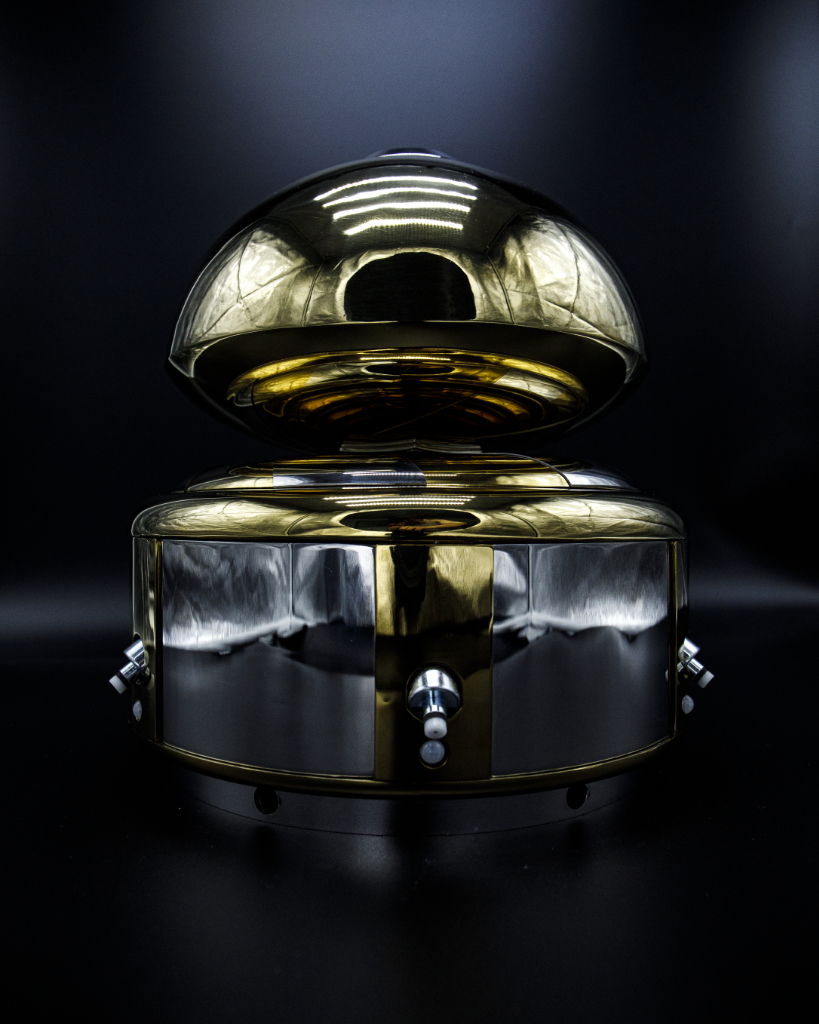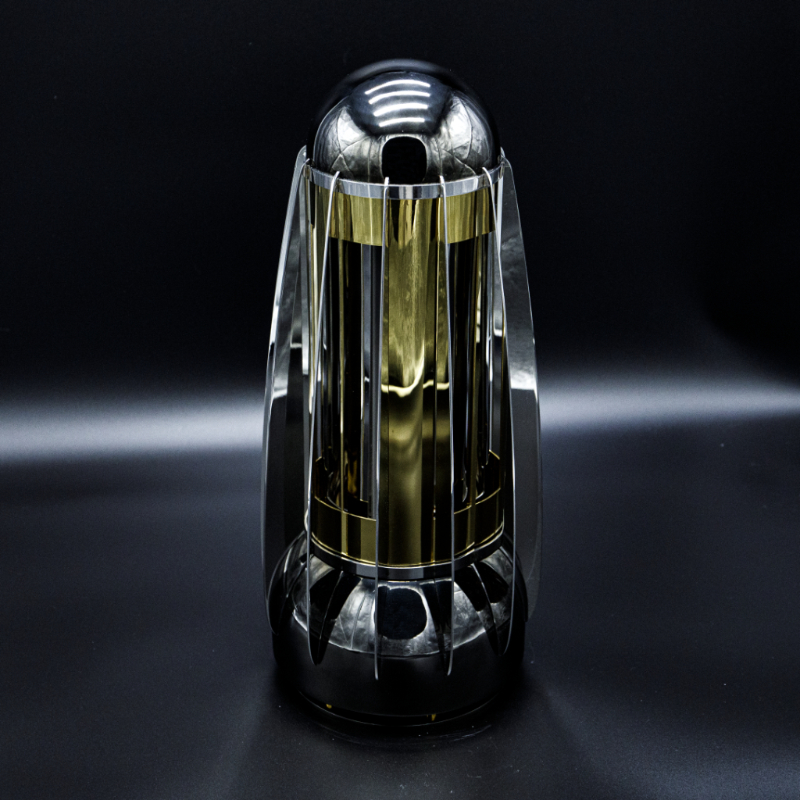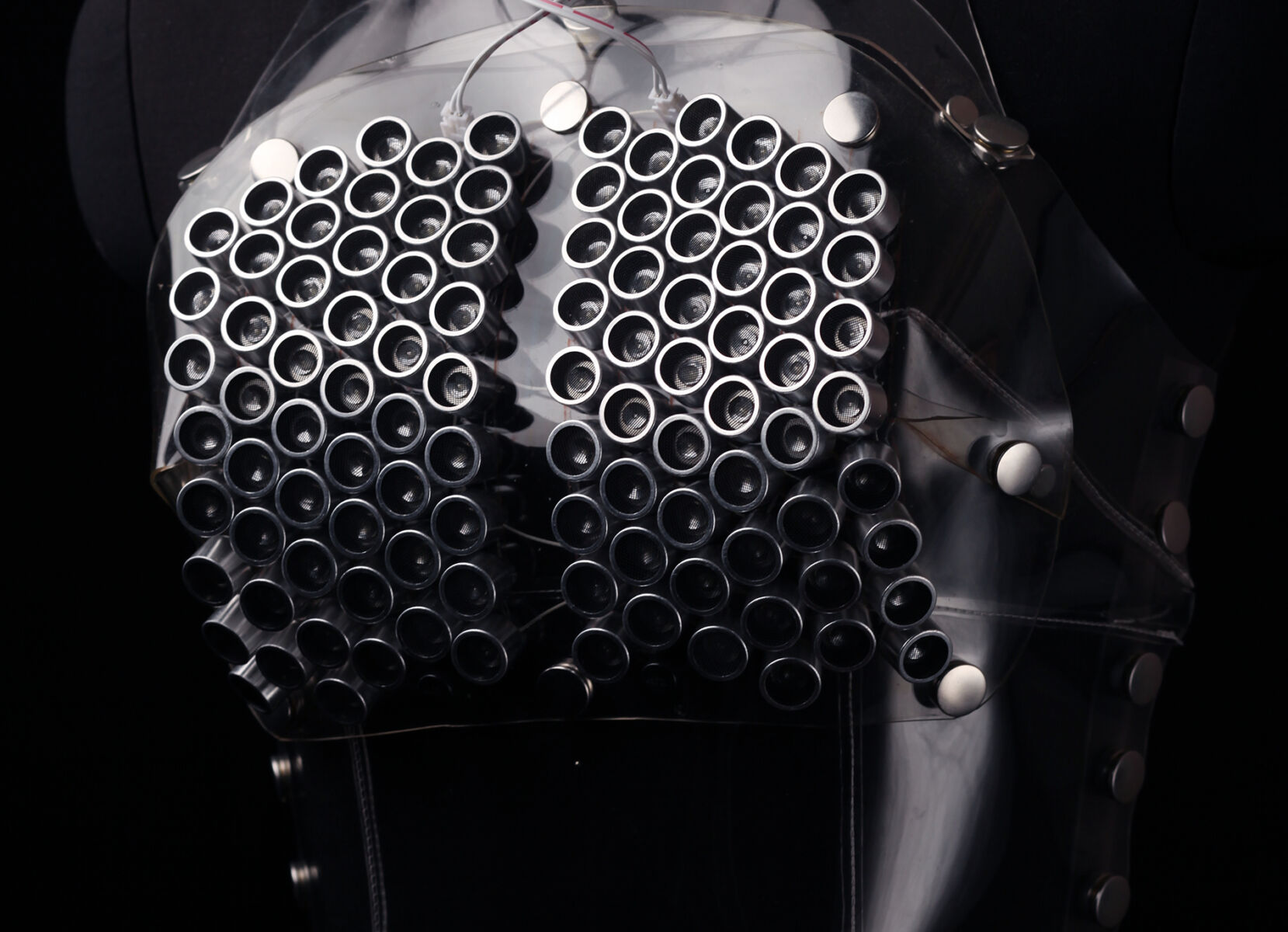Interview by Lyndsey Walsh

Vivian Xu and Benjamin Bacon have been working together to navigate entangled networks spanning across digital, organic, and physical realms for close to a decade. Together, Xu and Bacon have set out to explore emerging topics and formulate critical discussions about major societal and cultural issues present within virtual societies, disruptive technologies, and material ecologies. While both Xu and Bacon’s practices have been heavily influenced by their design background, their works and projects often fuse together and take influence from other aspects of their creative practices and professional histories, such as music and sound, film, and writing, to craft narratives and probe into the emerging possibilities about our future.
In 2015, Xu and Bacon founded the interdisciplinary and hybrid lab called Dogma Lab in Shanghai, China. Growing out of the unique ecosystem and environment of Shanghai, Dogma Lab has since gone on to venture into projects with focuses and outputs ranging from design and commerce to entertainment, art, and culture, as well as projects that fit within research and educational scopes. Working on both personal projects and commissions, Dogma Lab has produced events, installations, devices, sculptures, and research projects in both China and around the world.
More recently, they have taken their working model and research interests, which are deeply embedded in their work at Dogma Lab, and have applied it to their work in helping to create and drive research and educational programs at Duke Kushan University’s transdisciplinary media and arts labs in Suzhou, China. At Duke Kushan University, Bacon is an Associate Professor of Media and Arts and the Director of Signature Work, and Xu is an Assistant Professor of Media and Arts. Individually and on personal creative level, Xu and Bacon have also explored these transdisciplinary areas of interest and research in their own creative practices, which has manifested in a wide portfolio of transdisciplinary works that sit at the intersections of art, science, design, and technology.
Xu’s Skin Series is one of these works. The series investigates potential future possibilities of human perception and how wearable technologies can change a wearer’s relationship with their environment. Currently, the series features two wearable devices called Electric Skin and Sonic Skin, which, when worn, can augment touch and sound. Electric Skin seeks to extend a wearer’s ability to sense electrostatic flux in their environment by translating this information into touch sensation by using vibration motors that stimulate the wearer’s skin. Sonic Skin creates a type of sound armour around the wearer by projecting direction sound from the contours of the wearer’s body in a similar manner to how a bat’s or whale’s sonar system would work.
Bacon’s PROBE Series II: Subaudition follows a similar interest in the connections between technology and the environment. The workbuilds off of his previous work titled PROBE I: Averso Specillo Di Ducendum and presents itself as an investigation into speculative futures of space exploration. The series take inspiration from the Panspermia hypotheses, which suggests that life exists in outerspace and has travelled and landed on a receptive earth to inhabit. The Probe Series imagines a future where alien-conscious machines venture out from their home planets or origins to survive in the harsh conditions of space travel with the aim of probing and exploring the hostile conditions of our earth. PROBE Series II: Subaudition features a binary set of extra-planetary machines that have set out to explore subaudition by applying machine learning methods and text-to-speech recognition. Through this process, spoken language is degraded, and its meaning is decoded into kinetic energy, information transmission and visual representation, which includes the use of lights, patterns, colour, and reflection.
Both Xu’s Electric Skin and Sonic Skin and Bacon’s PROBE Series II: Subaudition were exhibited in together in Art Laboratory Berlin’s exhibition titled “Under the Viral Shadow: Networks in the Age of Technoscience and Infection”, which was curated by Regine Rapp and Christian de Lutz. The exhibition itself explored the complicated and messy ways that the language of the virus has infected our culture in these uncertain times. In the scope of the exhibition, Xu’s and Bacon’s work highlighted the interconnectedness of technological networks with both their environment and the living systems that they interact with.
While our future may be uncertain, Xu and Bacon’s creative explorations work to provide us with crucial and fascinating insights into the realm of possibilities and material visions that may or will emerge out of our technological, biological, and cultural networks.


For any of our readers who might not be familiar with your work, when did you meet, and what do you find drives you to create?
Benjamin Bacon: We met in 2011 in Beijing at a workshop I was organising with Tsinghua University that was part of the Weather Tunnel project in the TransLife New Media Triennial curated by new media curator Zhang Ga. At the time, both he and I were professors at Parsons, the New School for Design in New York, and this was a collaborative project between Parsons, Tsinghua, and the National Art Museum of China. Vivian was one of the participating artists in this project.
Vivian Xu: We didn’t start systemically collaborating as a team until 2014, when we founded Dogma Lab, an interdisciplinary design lab and consultancy in Shanghai. And since then, we’ve been working together as a duo more and more. We both have a film BA in undergrad and a Design and Technology MFA from Parsons, and we both work in higher education. We currently both teach at Duke Kunshan University in the Media Art and Digital Media programs. We’ve worked on many different types of projects, such as experimental performances, conceptual installations, educational programs, commercial design work, large-scale public art, and now more recently, design research and design and technology R&D.
BB: What drives our projects are often interesting questions and topics. We both have diverse interests that often fall at the intersections of design, technology, art, science, and education. These investigations often lead to projects that are at times art, but at times not. We learn a lot through these projects by engaging with different people. I guess the process of learning new things is what drives us.
VX: We bounce ideas around a lot in our creative process, and so we have this ecosystem of ideas between the two of us. I think in recent years, we realized, why not just work together more. Especially today, with many topics being highly interdisciplinary, two people with different perspectives and skillsets, but also a shared vision really helps make our collaborative work richer and deeper.
You both exhibited work and took part in Art Laboratory Berlin’s Under the Viral Shadow exhibition and accompanying conference. Vivian, your works Electric Skin and Sonic Skin featured two wearable devices that explored possibilities for technologically aided perception, and Benjamin, your work PROBE SERIES II featured a binary set of extra-planetary machines that set out to explore subaudition using machine learning methods of speech to text recognition. Can you tell us a bit about how you relate your works to the exhibition and how you think networks (technological, biological, and social) are changing and shifting in response to current events and technological advancements?
VX: I didn’t really begin my development of the Skin Series thinking about networks. This was a body of work that I’ve been working on for the past few years, mainly because I was interested in wearable technology and how this emerging area could really redefine our bodily relationship with the surrounding environment.
When I began designing and developing this series of works, I was really inspired by studies in sensory ecology and the parallels I saw with systems design in sensory technologies. My past work really focused on investigating the boundary between natural and technical systems, and the Skin Series continues in this vein through the development of wearables. I took more of a design approach to this work where I was looking at the sensory pathways of non-human animals and seeing if there was a potential to map these senses onto the human body through wearable technology and what that would feel like for the wearer of the suit. The Electric Skin looks at animals such as electric eels and certain bacteria; these species can receive and even send electric signals.
They experience the world around them through a layer of electricity. I thought with today’s society so saturated with digital signals, I wondered if it was possible to create a suit that tries to bring that layer of reality to the human experience and what would that type of reality feel like. The development of the suit was a long process for me because I was learning and developing myself. The suit works on a minimal level right now using capacitive touch technology but is not really the wireless communication approach I had originally imagined. I learned that antenna design is a very complicated thing, and I may not be able to achieve that in this project.
Similarly, the Sonic Skin looks at the auditory perspective of reality, referencing animals such as whales and bats that use sonar to communicate long-distance in dim environments. At the time, Ben had developed a little directional sound gadget for an auditory workshop. I had not worked a lot with sound in the past, and the way you could hear directional sound travel in space was really fascinating to me, and I thought, I want to incorporate this into my suit. The sound design for the Sonic Skin was also by Benjamin.
BB: For me, I sort of came of age at the dawn of the personal computer and the early World Wide Web. I got my first computer when I was 15 in the 80s, and I have since then always thought through the lens of systems and networks, especially how these systems and networks work, and so machines, in general, have always interested me because everything can in a way be defined as a conceptual machine.
Another influence that’s affected me has been the area of space exploration and the idea of alternative ways of being and living in alien habitats. Specifically, with the Probe Series, I was investigating different spaceship and machine designs that could break through the physical limitations put on carbon-based life forms on Earth when travelling through space. The concept of panspermia originated from the biological realm in thinking about how microbes in space can generate on planets, but this perspective has also been incorporated by physicists like Michio Kaku in thinking about the most effective ways to build space probes.
The Probe Series follows this train of thought, where each instalment of the larger series investigates one aspect of sensory perception (i.e. vision in Probe I and sound in Probe II) and data collection and analysis. In designing each probe or probe set, I consider the human sensory system and try to imitate and modify it in the machine system design with the assistance of ML models. In the case of Probe Series II: Subaudition, the two machines together imitate the human ear and language processing system in the brain in how we pick up sound signals, translate that into electrical signals, and then reinterpret that into an internal language to our bodies, in the case of the machine, binary language expressed through tapping. In the actual execution of this process, environmental sounds, the mistranslation in the machine, and glitches of the ML models due to data training limitations all influence what is stored and expressed through the machines.
This creates an interesting dynamic where the machines almost exhibit their own interpretation of what human language is. During the exhibition, Regine, Chris and their team noticed that the machines kept picking up the Sonic Skin’s noises as if it was language. This was really a pleasant surprise to me because you have all these ideas and then work to design these machines, but it’s always hard to know how they will behave in the wild. This really made me think about how AI models could be investigated as dynamic and complex archives for human culture and how reliable or unreliable these archives may be.
While you have worked together on numerous projects, your recent collaborative work Horologic Solum is an exploration and a case study about media memory. Can you tell us about the inspiration for this work and the process of making it?
BB: We were approached by new media curator Iris Long towards the end of 2020. She and artist/curator Qiu Zhijie were working on an exhibition with the Shenzhen government called The Final Prophet, reflecting on the past year under the pandemic. Earlier in Spring that year, Vivian and I had been working on a digital archive initiative called the COVID-19 Memory Archival Project with students in documenting pandemic experiences through interactive media-rich personal narratives utilizing the GIS Storymap platform that had just been released not long ago. I presented this project at a conference at Duke, and we later co-authored a book chapter reflecting on memory and media.
VX: In relation to the pandemic, this question of culture as a living experience passed down and the limitations of media to capture became an idea that we thought a lot about during 2020. For example, there were so many factors that caused the forgetting of the last great pandemic post-WWII, which was only 100 years ago. We had to relearn that experience in 2020 because we had forgotten. This really led us to think about the breakdown of communication beyond individual people and generations, communication that needed to happen over vast stretches of space and time.
BB: Building on that, the case of Voyager’s 1977 Golden Record then became really interesting because it was really conceived as a snapshot of civilization at the time and sent out for the purpose of communicating with potential aliens. But if you really break down this event and its implications, you will find that it really asks the question: Are we all alone in time and space? Which is a very isolating thought and almost makes you feel sad. If this artifact ever reaches other types of living forms, and if it does, will it still be intact, and if it’s intact, will they be able to access the information, and so on… It seems the chance of sending a message into the future is very small. And even if it reached someone, what would it matter because our civilization could be long gone by then?
VX: It seems that at the point where the original record was sent off into space, that snapshot of humans diverged along two paths, where the actual golden record artifact and its cultural memory began moving further and further away from each other both literally and metaphorically. The concept of the Golden Record through history passed through the tape decks that transmit that information is broken up into 5 layers of time in the installation: the time of the content recording, the internal time of the machines playing the content, the time of tape loop cycles, the time when the tape snaps, and the time and space of the audience. At any point, communication can break down, and the piece or performance could be over.
BB: The production of the piece was very low-tech. We chose to use Japanese tape decks from the early 80s. This was an intentional choice because most people have a concept of what the late 70s early 80s feel like, but it’s not until you look at a piece of technology from that era that you realize how far we’ve come from that in just a few decades. By choosing tape decks, you are viscerally brought back to the time of the original recordings. We are so used to the digital age that we often don’t think of the materiality of mediums anymore in a visceral way and what archives mean physically.
VX: There was a lot of experimentation in creating the decay system for the tapes. This decay system would slowly smooth away the tape over a period of 8 hours until finally, it broke, and the sound piece ended. Ben probably anticipated this because he’s worked with sound for much longer, but what I found really fascinating was the points where the tape wasn’t yet broken, but the meaning of the sounds disappeared and became just white noise. It was really random because it depended on how the material rubbed off.
Together you both also founded the transdisciplinary design lab called DOGMA Lab, where you have engaged in a variety of projects spanning education, branding, product, wearables, audio, research, and more. What has been your favourite project that you have gotten to work on together, and are there any challenges that you run into when working together?
VX: As mentioned before, we founded Dogma Lab in 2014. Between 2014-2017, we worked mainly on commercial projects through the lab. One of these projects was the Xintiandi Christmas installation we did in 2017. For this project, we built a 15-meter tall 2-level Snow Globe playground with over 1500 meters of interactive lights controlled by custom designed touch panels that allowed audiences to engage with the installation. This project was a big challenge for us. This was a large budget production that spanned between March 2017 till January 2018. We managed a multi-continental team in designing and developing this project.
BB: We had experience with interactive work in the past, but we’ve never built an interactive building before, or a building at all. We had to learn about construction and building regulations on the job. We were very lucky to have a stellar construction team supporting us. And friends who had extensive experience working in commercial design gave us advice and support. I wouldn’t say this is our favourite project, but definitely, one where we were pushed most out of our comfort zones and where we learned the most.
Additionally, you both work on your own and together with extensively different aspects of technology and sound. Your collaborative work “Bio-harmonic Quartet” links musicians and artists via a biofeedback network and generates music and soundscapes in collaboration with an AI. How do you see the role of technology continues to shift and alter the ways in which we produce music and sound and how was your experience of collaborating with an Artificial Intelligence?
BB: This project started as a conversation with a musician friend B6 (Lou Nanli), when talking about music production. Prior to this project, I had given a TED Talk in Ningbo about how new technologies developing under the umbrella of Industry 4.0 is currently revolutionizing the music industry. Compared with the third industrial revolution, which was tied to the personal computer, the fourth industrial revolution is moving productivity away from the creation of information and things into the area of re-defining methods and processes of production. This project was heavily influenced by these ideas.
VX: Before this project, Ben had done several works exploring the possibilities of AI-generated music. In this project, we expanded on that and played with the idea of a decentralized human-machine network that could collaborate in music-making. We were very lucky that our friend B6 invited us to be part of his solo concert Flowers, and we got to engage with performers from the Shanghai Philharmonic. We presented preliminary experiments at the time. We would like to develop some of these ideas further with more time.
What are some things that you are working on now, and what are some of the ideas that fascinate you that you would want to explore more in the future?
BB: For my individual research, I’m currently continuing my explorations on machine logic and system design with the Probe Series and another new series called Conditionals that will explore logic building blocks in computational systems. I’m also getting back into BCI interfaces and experimenting with this technology as a creative medium.
VX: I’m continuing development in the Skin Series by creating a third wearable looking at bioluminescence. I’m also getting back to another older unfinished project that looks at silkworms and their relationship with human labour and weather through the form of an artist’s book.
BB: We are also working on several new initiatives and projects together. One of these projects is a design research project in collaboration with another colleague at Duke Kunshan University, Dr Yajuan Lin, who is a biological oceanographer. We are working with data and research provided by her lab and collaborators that look at the biodiversity and carbon flux of micro-planktons in the Antarctic Ocean. Her research seeks to understand how changes in these communities can indicate changes in the larger ecological environment of this region. We are working with her to design and develop ways to bring this knowledge to the wider public through VR experiences.
VX: This is a project we’re really excited about, and it’s been helping us think more deeply about mixed reality networks on a global and ecological scale and how these realities can be brought into the digital space through data.
What’s the chief enemy of creativity?
BB: Trends.
VX: Assumptions.
You couldn’t live without…
Both: Curiosity.






